Common Snakes of North Carolina: There are over 37 different species of common snakes of North Carolina, a state that offers both mountain regions and coastal plains, perfect spots for many reptilian species. When you add over seventeen river systems and plenty of crop growing and vegetation, you have yourself a snake-playground with plenty of places to hide, find prey and camouflage themselves. Here are the common snakes of North Carolina:
Call the below number for snake removal help in your area:
Charlotte area: 704-419-8169
Fayetteville area: 910-459-4358
Greensboro area: 336-398-3990
Raleigh/Durham: 919-825-2060
Below are common snakes of North Carolina. To identify the dangerous ones, click on the Venomous Snakes of North Carolina page.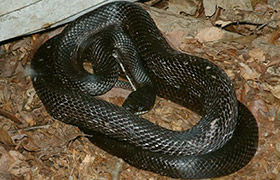
Rat Snakes: Both the black and gray rat snakes can be found in North Carolina, and these feed on things such as lizards, mice, rats, copperhead snakes (venomous) and more. These rat snakes are actually very good in keeping the numbers of dangerous snakes down (and away from residential areas) as well as keeping rodent numbers down too.
The snake sometimes looks a little like the copperhead snake to some people but the two shouldn’t be confused - the rat snake is not venomous whereas the copperhead is. As youngsters, you may spot rat snakes around suburban areas - outbuildings, garages and sheds tend to be quite popular as well as getting inside residential properties too.
The snake sometimes looks a little like the copperhead snake to some people but the two shouldn’t be confused - the rat snake is not venomous whereas the copperhead is. As youngsters, you may spot rat snakes around suburban areas - outbuildings, garages and sheds tend to be quite popular as well as getting inside residential properties too.
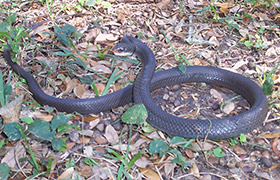
Racer Snakes: The black racer, light racer and young racer are all common snakes of North Carolina, snakes that grow to around 70 inches in length and look a little like the black rat snake. Living in meadows, rocky hillsides and brushy areas, the it eats lizards, frogs, mice, eggs and insects, often bringing it closer to homes and outbuildings, much like the rat snake.

Corn Snakes: These snakes make for great pets and are common snakes of North Carolina, coming in a wide range of colors, patterns and sizes. Usually incorporating shades of tan, brown, red, beige, yellow and orange with black borders and often a diamond-shaped design running along the length of it, it’s pretty docile and doesn’t usually snap. Often confused with the copperhead, a venomous snake, and even the rat snake, there is nothing dangerous or aggressive about this little guy, often found slithering along the ground in a diverse range of habitats.
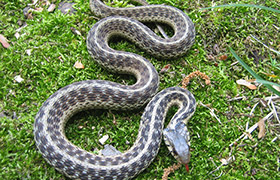
Garter Snakes: Both the common garter snake and the striped garter snake can be found in this state, one that can come in many designs and colors just like the corn snake. Found more often than not in the mountain regions, they eat frogs, toads, and other water-swelling creatures, meaning they can also be found in moist vegetation. They will lash out if threatened, releasing a musky, foul smell, but there won’t be any lasting damage and there is no venom to worry about.
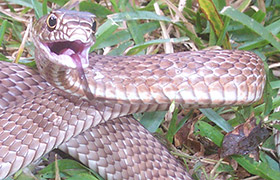
Coachwhip: A long and thin snake that’s given a great name because of its ability to whip its body and move incredibly fast, sandhills, grassy dunes, flatbeds and forests surrounding water are all preferable habitats, providing an easy source of food like lizards, other small snakes, birds, mice and eggs again.
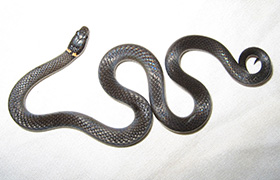
Ringneck Snake: Another snake you probably wont see because of its secretive nature, the ringneck snake will have a variety of colors ranging from creamy yellow to blacks, oranges, reds, browns, greens and more. The name is given because of the highly visible ring around its neck. Feeding on newts, toads, frogs, slugs, worms and other moist and water-dwelling animals, you will often find it among watery areas but prefers to be hidden in the bark loose on trees, under log or rock piles, and even within the soils or moist vegetation.
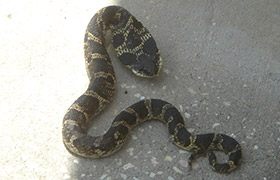
Hognose Snake: Also known as the ‘false puff adder’, the hognose snake swells its head up much as the name suggests, looking much scarier and life-threatening than it actually is. Even when handled, this snake rarely bites, preferring to make a noise rather than fight.
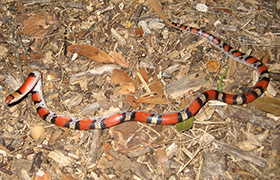
Scarlet Snake: Sticking with snakes that look venomous but aren’t, the scarlet snake is another prime example of that, mimicking the dangerous coral snake’s markings. Only growing to around 25-26 inches in length, this is one of the smallest snakes you’ll need to worry about in North Carolina, and it eats things like reptile eggs, smaller snakes, mice, lizards and insects.
Again, both the rough and smooth green snakes are common snakes of North Carolina, a snake given its name because of its bright green color, allowing it to easily become camouflaged in the green grasses of back yards and other residential places. Usually a snake that dwells in trees, it isn’t normally bad-tempered although will become agitated if threatened and cornered, and usually eats insects such as spiders, caterpillars, crickets and grasshoppers.
Earth Snake
The smooth and rough earth snake are pretty dull looking snakes, usually a one-tone brown, perfectly camouflaged in the mud, soil and ground it hides in. If you have a compost pile, you might find this snake, and you’ll also spot them under piles of leaves and even in decaying, rotting trees in highly forested areas. Eating things like small frogs, slugs, snails and worms, it’s more likely to scurry away frightened than it is come out and fight making it a snake you really won’t need to worry about.
Milk Snakes
You might spot the eastern milk snake in North Carolina, a snake with bright colors that looks as if it should be dangerous and venomous but isn’t at all. Small, only growing to around 45 inches in length maximum, it eats other smaller snakes as well as lizards and mice.
Eastern King Snake
A snake that seems to be very common in most places of south eastern USA, the eastern king snake or king snake, is a really docile snake that can often be found hunting for prey in residential areas. Although quite large, it prefers the taste of lizards, mice, eggs, and even other snakes including the venomous copperhead. It is rare that you will see this snake.
There are a few others you may need to know about when looking at the common snakes of North Carolina and these include the northern water snake, the redbelly water snake, the queen snake, the southern crowded snake and the redbelly snake. All of the snakes mentioned here are non-venomous and will not strike if you leave them alone. If you corner the snake, or attempt to handle it in anyway, there is a chance it will lash out. For more information, go to my Snake Removal - How to Get Rid of Snakes home page.
Call the below number for snake removal help in your area: